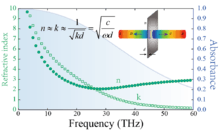Coherent perfect absorber
A coherent perfect absorber (CPA), or anti-laser, is a device which absorbs coherent light and converts it to some form of internal energy such as heat or electrical energy.[1][2] It is the time-reversed counterpart of a laser.[3] The concept was first published in the July 26, 2010, issue of Physical Review Letters, by a team at Yale University led by theorist Douglas Stone.[4][5] In the September 9, 2010, issue of Physical Review A, Stefano Longhi of Polytechnic University of Milan showed how to combine a laser and an anti-laser in a single device.[6] In February 2011 the team at Yale built the first working anti-laser.[7][8] It is a two-channel CPA device which absorbs the output of two lasers, but only when the beams have the correct phases and amplitudes.[9] The initial device absorbed 99.4 percent of all incoming light, but the team behind the invention believe it will be possible to achieve 99.999 percent.[7] Originally with the FP cavity, the optical CPA operates to a specific frequency and the wavelength-thick material. In January 2012, thin-film CPA has been proposed by utilizing the achromatic dispersion of metal, exhibiting the unparalleled bandwidth and thin profile advantages.[10] This theoretical evaluation was experimentally demonstrated in 2014.[11] In the March 21, 2019, issue of Nature, a team from TU Wien (Austria) and from the University of Nice (France) presented the first experimental realization of a multi-channel CPA in a disordered scattering medium, which considerably expands the field of possible applications.[12] In this first implementation of a random anti-laser (i.e., the time-reverse of a random laser) an absorption of more than 99.78 percent of the incoming intensity was achieved.

Design
In the initial design, identical lasers are fired into a cavity containing a silicon wafer, a light-absorbing material that acts as a "loss medium". The wafer aligns the light waves from the lasers so they become trapped, causing most of the photons to bounce back and forth until they are absorbed and transformed into heat. Furthermore, many of the remaining light waves are cancelled out by interfering with each other.[2][7] In contrast, a normal laser uses a gain medium which amplifies light instead of absorbing it. A different setup was used for the first experimental demonstration of a CPA in a disordered medium (random anti-laser).[12] Here, a metallic waveguide was used with a set of randomly placed scattering objects placed inside. In the middle of this "disordered medium", an antenna was introduced, at which the signal injected into the waveguide can couple out. To reach the CPA condition, the injected wavefront of the microwaves were shaped at altogether eight external antennas and the coupling strength of the central antenna was tuned by moving it in and out of the waveguide.
Applications
Coherent perfect absorbers can be used to build absorptive interferometers, which could be useful in detectors, transducers, and optical switches.[4] Another potential application is in radiology, where the principle of the CPA might be used to precisely target electromagnetic radiation inside human tissues for therapeutic or imaging purposes.[7] Moreover, the CPA concept might be exploited to achieve perfect focusing of acoustic or electromagnetic signals on receivers even when they are embedded in complex environments.[12]
References
- Gmachl, Claire F. (2010). "Laser science: Suckers for light". Nature. 467 (7311): 37–39. Bibcode:2010Natur.467...37G. doi:10.1038/467037a. PMID 20811446.
- "Behold, the Antilaser". Science News. Archived from the original on 2012-11-15. Retrieved 2010-09-07.
- Longhi, Stefano (2010). "Backward lasing yields a perfect absorber". Physics. 3: 61. Bibcode:2010PhyOJ...3...61L. doi:10.1103/Physics.3.61.
- Chong, Y.; Ge, Li; Cao, Hui; Stone, A. (2010). "Coherent Perfect Absorbers: Time-Reversed Lasers". Physical Review Letters. 105 (5): 053901. arXiv:1003.4968. Bibcode:2010PhRvL.105e3901C. doi:10.1103/PhysRevLett.105.053901. PMID 20867918.
- Stefano Longhi (2010). "Backward lasing yields a perfect absorber". Physics. 3: 61. Bibcode:2010PhyOJ...3...61L. doi:10.1103/Physics.3.61.
- Stefano Longhi (2010). "PT-symmetric laser absorber". Physical Review A. 82 (3): 031801. arXiv:1008.5298. Bibcode:2010PhRvA..82c1801L. doi:10.1103/PhysRevA.82.031801. (Synopsis by Mark Saffman.)
- "Scientists Build the World's First Anti-laser". Yale University. 2011-02-17. Archived from the original on 2011-02-21. Retrieved 2011-02-17.
- "Scientists build the world's first anti-laser". BBC. 2011-02-17. Retrieved 2011-02-17.
- Wan, W.; Chong, Y.; Ge, L.; Noh, H.; Stone, A. D.; Cao, H. (2011). "Time-Reversed Lasing and Interferometric Control of Absorption". Science. 331 (6019): 889–892. Bibcode:2011Sci...331..889W. doi:10.1126/science.1200735. PMID 21330539.
- Pu, M.; Feng, Q.; Wang, M.; Hu, C.; Huang, C.; Ma, X.; Zhao, Z.; Wang, C.; Luo, X. (17 January 2012). "Ultrathin broadband nearly perfect absorber with symmetrical coherent illumination". Optics Express. 20 (3): 2246–2254. Bibcode:2012OExpr..20.2246P. doi:10.1364/oe.20.002246. PMID 22330464.
- Li, S.; Luo, J.; Anwar, S.; Li, S.; Lu, W.; Hang, Z.H.; Lai, Y.; Hou, B.; Shen, M.; Wang, C. (2015). "Broadband Perfect Absorption of Ultrathin Conductive Films with Coherent Illumination: Super Performance of Electromagnetic Absorption". Physical Review B. 91 (22): 220301. arXiv:1406.1847. Bibcode:2015PhRvB..91v0301L. doi:10.1103/PhysRevB.91.220301.
- Pichler, Kevin; Kühmayer, Matthias; Böhm, Julian; Brandstötter, Andre; Ambichl, Philipp; Kuhl, Ulrich; Rotter, Stefan (2019-03-21). "Random anti-lasing through coherent perfect absorption in a disordered medium". Nature. 567 (7748): 351–355. doi:10.1038/s41586-019-0971-3. ISSN 0028-0836. PMID 30833737.